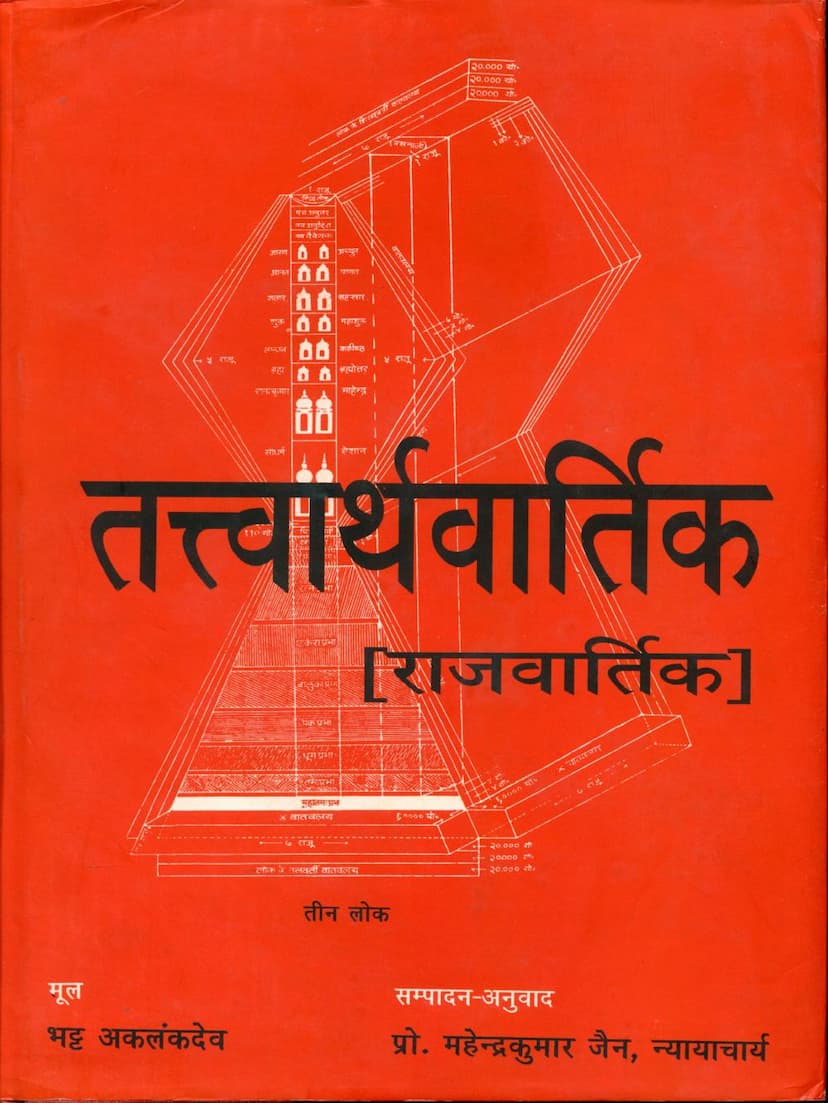Tattvarth Varttikam Part 02
Added to library: September 2, 2025

Summary
This document appears to be a comprehensive index or table of contents, along with introductory pages, for the second part of the Jain text "Tattvarth Varttikam." Here's a breakdown of what the provided text covers:
Book Information:
- Title: Tattvarth Varttikam Part 02
- Author(s): Akalankadev, Mahendrakumar Jain
- Publisher: Bharatiya Gyanpith
- Catalog Link: https://jainqq.org/explore/022021/1
- Publisher: Bharatiya Gyanpith
- Edition: Eighth Edition : 2009
- Price: Rs. 250
- ISBN: 81-263-0660-2 (Set), 978-81-263-1798-1 (Part-II)
- Series: Moortidevi Jain Granthamala : Sanskrit Grantha No. 20
- Edited and Translated by: Prof. Mahendrakumar Jain, Nyayacharya
Content Summary (Pages 2-18 - The Table of Contents):
The table of contents reveals that this volume is a detailed commentary (Varttikam) on the Tattvarthasutra by Umāsvāmī, composed by Ācārya Akalankadeva. It follows the structure of the original text, covering various philosophical and spiritual concepts of Jainism. The content is organized by chapters and sections, delving into specific topics within each.
Here's a glimpse of the topics covered, based on the chapter headings and keywords:
-
Chapter 5 (Panchamō Adhyāya): Focuses on the Ajiva Dravya (non-soul substances). It discusses:
- Dharma, Adharma, Ākāśa, Pudgala (the five Ajiva substances).
- The nature of Kāyas (bodies/substances) and their constitution (e.g., multi-regionality).
- The characteristics and definitions of Dharma, Adharma, Ākāśa, and Pudgala.
- Discussions on Anu (atom), Skandha (aggregate/molecule), Mūrti (form/corporeality).
- The concept of Prakriti (nature), Parinama (transformation), Kriya (action), Gati (movement), Sthiti (stasis), and Upagraha (support/aid).
- The nature of Kāla (time).
- The concept of Loka (universe) and Aloka (non-universe).
- The Lokākāśa (universe space).
-
Chapter 6 (Shashṭhō Adhyāya): Focuses on Āsrava (influx of karma). It covers:
- The definition of Yoga (activity of mind, speech, and body) as the cause of Asrava.
- The distinction between Yoga and Kriya (action).
- The types of Āsrava – Punya (meritorious) and Pāpa (demeritorious).
- The causes of Mithyādarśana (false belief), Avirati (non-restraint), Pramāda (negligence), Kaṣāya (passions), and Yoga as causes of bandha.
- Detailed discussion on Kaṣāyas (Krodha, Māna, Māyā, Lobha) and Nokaṣāyas (Hāsya, Ratī, Aratī, Śoka, Bhaya, Jugupsā, etc.).
- The causes of Āyu Bandha (age-group karma influx) – Naraka, Tiryagyonī, Manuṣya, Deva.
- The causes of Nāma Karma (name karma) influx, discussing various types like gati, jāti, śarīra, etc.
- The causes of Goti (species of birth), Jāti (species of life form), Śarīra (body types), Angopāṅga, Nirmāṇa, Bandhana, Saṁghāta, Saṁsthāna, Saṁhanana.
- The causes of Bandha (karma bondage).
-
Chapter 7 (Saptamō Adhyāya): Focuses on Saṁvara (cessation of karma influx) and Vratas (vows). It covers:
- The definition and importance of Saṁvara.
- The five Mahāvratas (great vows) and their numerous Aticāras (transgressions).
- The five Aṇuvratas (minor vows) and their numerous Aticāras.
- The discussion of Mahāvrata and Aṇuvrata.
- The detailed explanation of Māyā (deception), Nidāna (wrong aspiration), and Mithyādarśana (false belief) as causes of transgressions.
- Dāna (charity/giving) and its various aspects.
- The practices leading to Saṁvara: Gupti (restraint), Samiti (carefulness), Dharma (virtues), Anuprekṣā (contemplation), Pariṣaha Jaya (endurance of hardships), and Cāritra (conduct).
- The detailed breakdown of Pariṣaha (hardships) and their spiritual significance.
- The discussion on Tapas (asceticism) – both Bahya (external) and Abhyantara (internal).
-
Chapter 8 (Ashṭamō Adhyāya): Continues the discussion on Bandha (karma bondage) and its nuances. It covers:
- The causes of Bandha: Mithyādarśana (false belief), Avirati (non-restraint), Pramāda (negligence), Kaṣāya (passions), and Yoga (activity).
- Detailed classification of Mithyādarśana (natural, per-instruction).
- The specific causes of Āyu Bandha (age karma influx) for different life forms: Naraka (hell beings), Tiryagyonī (animals), Manuṣya (humans), and Deva (celestial beings).
- Nāma Karma (name karma) – covering its various types like gati (destination), jāti (life-form species), śarīra (body types), saṁhāna (body structure), etc.
- The concept of Bandha (bondage) in terms of Prakriti (nature), Sthiti (duration), Anubhāva (intensity), and Pradeśa (quantity).
-
Chapter 9 (Navamō Adhyāya): Focuses on Saṁvara (cessation of karma influx) and Nirjarā (shedding of karma). It covers:
- Saṁvara as the cessation of Āsrava.
- The spiritual Guṇasthānas (stages of spiritual progress) which are essential for Saṁvara and the path towards Nirjarā.
- Detailed explanation of Gupti (restraint of senses, mind, speech) and Samiti (carefulness in conduct).
- The importance of Dharma (virtues) like Kṣamā (forgiveness), Mārdava (humility), etc.
- The role of Anuprekṣā (contemplation) on the nature of reality (impermanence, suffering, emptiness, etc.).
- The significance of Pariṣaha Jaya (endurance of hardships) in spiritual progress.
- The practice of Cāritra (conduct) in its various forms.
- The concept of Tapas (asceticism) – both Bahya (external) and Abhyantara (internal).
- The process of Nirjarā (shedding of karma), its types, and how it is achieved through Tapas and virtuous conduct.
-
Chapter 10 (Daśamō Adhyāya): Focuses on Mokṣa (liberation) and related concepts. It covers:
- The nature of Mokṣa as the complete cessation of karma and liberation from the cycle of birth and death.
- The final stages of Samyama and Tapas leading to Mokṣa.
- The description of Kevalī (omniscient beings) and Siddhas (liberated souls).
- The characteristics of Mokṣa Sukha (bliss of liberation).
- The concept of Kaivalya (absolute spiritual attainment).
- The process of Mokṣa and the final state of the liberated soul.
Overall Significance:
The text, "Tattvarth Varttikam Part 02," authored by Akalankadeva and edited by Mahendrakumar Jain, is a profound commentary on the foundational Jain scripture, Tattvarthasutra. It elucidates the core principles of Jain philosophy, including the nature of soul (Jiva) and non-soul (Ajiva) substances, the causes of karma influx (Āsrava), the means of its cessation (Saṁvara), the shedding of karma (Nirjarā), and ultimately, the path to liberation (Mokṣa). The text emphasizes Anekāntavāda (the doctrine of manifold aspects) as a means to resolve philosophical disagreements and establish a comprehensive understanding of reality. Its detailed explanations of vows, conduct, contemplation, and ascetic practices make it a valuable resource for serious students of Jainism. The commentary's thoroughness aims to fulfill the need for a complete explanation of Tattvartha's teachings.